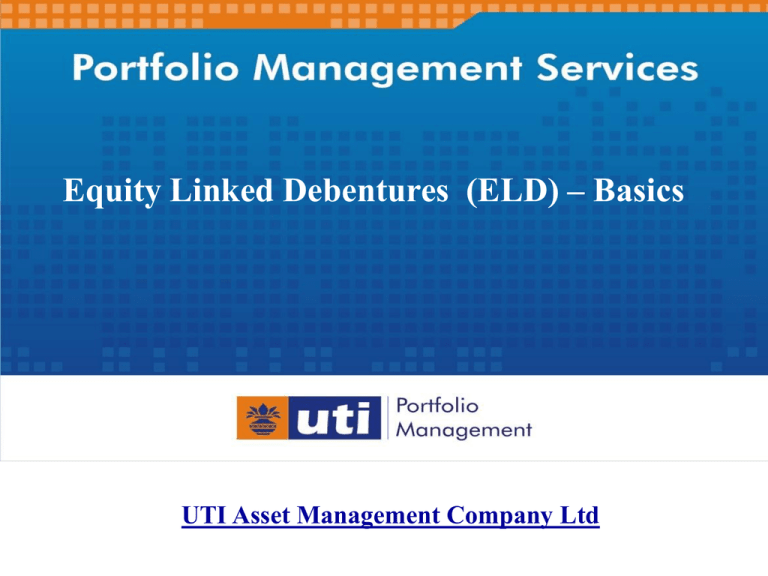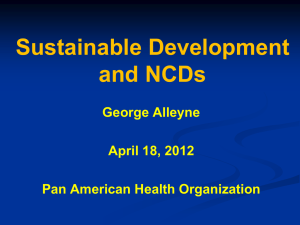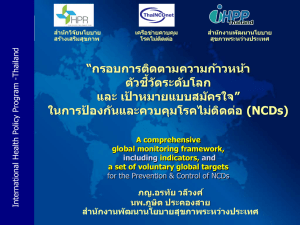UTI PMS ELD Basics – Presentation
advertisement

Equity Linked Debentures (ELD) – Basics UTI Asset Management Company Ltd Equity Linked Debentures With the high volatility in the equity markets, investors are increasingly looking at financial products which provide stability along with decent returns. ‘Equity-Linked Debentures’ (or ELDs) are products that provide: 1) Capital protection, 2) A slice of the stock market based returns What are ELD’s An ELD is a form of a fixed income product. It differs from standard fixed-income product as the final payout is also based on the return of the underlying equity, which can be a set of stocks, basket of stocks or an equity index (all pre-defined) It is structured so as to give 100% capital protection with a provision for equity participation. Bonds are rated by an accredited rating agency. Simply put… ‘Equity Linked Debentures’ are popularly known as capital protection funds & give you the upside of equities and protect the downside! Risk Return Reward As per the risk return chart above, ELDs offer better returns than FMP at a lower risk than equities. Typical Payoff Scenario In a typical payoff scenario, as illustrated above, ELDs, on an average, offer better returns than FMPs and even when the Nifty goes down, you recover your principal amount. Who Can Apply Broad theme of ELD’s These bonds are linked to an index like the Nifty or any/group of equity shares. The issuer of bonds may invests a pre-determined part of the principal amount collected in fixed income securities like bonds, which provide principal protection. The balance maybe invested in call options which provide the exposure to equity or stock index. Who Can Apply Illustration The returns are calculated in this manner: Say, the fund house comes to an initial value of the Nifty, which is often the average of the first three months. Also suppose, the Nifty’s value has been 3,800, 4,000 and 4,200 at the end of months 1, 2 & 3: Their average is worked out to be (3800+ 4000 + 4200)/3 = 4,000. Contd … The final value is also calculated as the average of the last three months. Now, if the Nifty’s value closes at 5,000, 5,200, 5,500 in months 13, 14 and 15 respectively, we can calculate the average to 5,233. So, the final Nifty returns come out to (5233 4,000)/4,000*100 = 30.82 per cent over the threeyear period. The Nifty return, multiplied by the participation ratio (that is pre-decided by the fund) is the final return. Participation Ratio Participation Ratio is the ratio at which ELD participates in the appreciation of the underlying equity index (say the Nifty). E.g. Participation Ratio of 100% implies that a 10% increase in the Nifty will result in a final equity-linked coupon of 10%. In a nut shell Principal Remains Intact + Equity Market Participation = Equity Linked Debentures (ELD) Remember… Equity linked debenture schemes do not allow premature exits. All benefits are subject to investment being held till redemption date. These products, though listed on the exchanges, are a bit illiquid and hence difficult to sell or transfer. In certain cases, the issuer or arranger of the notes may offer to buy back the notes at a certain cut-off. To Sum up If investors model and balance their portfolio in a disciplined manner and then hold it long term, they will derive the same benefits as that of an equity linked plan. By investing in these schemes, on the upside, they may get a return related to the appreciation of the Nifty. At worse, they won't lose their capital. PMS: Risk Factors Risk Factors : Portfolio investments are subject to market and other risks and consequently, the Portfolio Manager makes no guarantee or assurance that the objectives set out in the agreement or otherwise shall be accomplished. The value of the portfolio may increase or decrease depending upon market conditions and factors affecting capital markets such as de-listing of securities, market closure, insufficient volumes and Macroeconomic factors like economic slowdown, unanticipated corporate performance, environmental or political problems, changes to monetary or fiscal policies, changes in government policies and regulations with regard to industry and exports. Consequently, the Portfolio Manager makes no assurance of any returns on the Portfolio. Past performance of the Portfolio Manager does not guarantee the future performance of the same and investors are not offered any guarantee or assurance on portfolio returns. Equity instruments carry both company specific and market risks. Debt securities are subject to credit risk, interest rate risk, default risk etc. Accordingly the value of investments may appreciate or depreciate, hence no assurance of returns can be made for these investments and any loss arising from decisions taken by the portfolio manager shall be assumed by the Client. Derivative products are affected by various risks including but not limited to counter-party risk, market risk, valuation risk, liquidity risk and basis risk. An exposure to derivatives in excess of the hedging requirements can lead to losses. An exposure to derivatives can also limit the profits from a genuine investment transaction. Efficiency of a derivatives market depends on the development of a liquid and efficient market for underlying securities and also on the suitable and acceptable benchmarks. The portfolio manager is not responsible or liable for any loss resulting from the operations of the portfolio. Further the portfolios are subjected to reinvestment risk arising due to uncertainty in the rate at which cash flows from an investment may be reinvested and Non Diversification risk which arises when the portfolio is not sufficiently diversified by investing in a wide variety of instruments. Liquidity risk arises when investments are often restricted by factors such as trading volumes, settlement periods and transfer procedures. Further the Client may suffer a loss on account of Settlement risk in transferring securities and non availability of price information from the stock exchanges. Risk factors inherent to equities and debt securities are also applicable to investments in mutual fund units, which in addition could be affected by events like change in the fund manager, take over and mergers of mutual funds, foreclosure of schemes or plans etc. Disclaimer This document is issued by UTI Asset Management Company Ltd. and is only for general information purpose. This document does not constitute any offer, recommendation or solicitation to any person to enter into any transaction or subscribe to any services. It does not serve as or replace or amend the terms or nature of any products or services offered by the company. The recipient of this material alone shall be fully responsible / liable for any decision taken on the basis of this material. All recipients are advised to make their own investigation, their own independent judgement with respect to any matter contained herein. Services discussed herein may not be suitable for all investors and appropriate professional advise should be obtained before acting on any information herein. Additional Risk Factors Non Convertible Debentures 1. 2. 3. 4. 5. 6. 7. 8. 9. 10. 11. The above details of NCDs are as intimated by the issuer and are only indicative. The issuer may issue NCDs with modifications to the above mentioned details and the Portfolio Manager reserves the right to either accept or reject it. However Portfolio Manager may at it’s discretion decide not to apply to these NCDs and return the funds to various investors, in case : a. There is any change in key Terms b. In the opinion of the Portfolio Manager the total Application amount received under this series does not justify investment in these NCDs, etc. c. The issuer decides not to issue / allot the NCDs due to such reasons as it deems fit, in which case , no issue / allotment of NCDs will be made. If the issuer chooses to revise the issue opening date/issue closing date/ date of allotment of the NCDs, the Portfolio manager retains the right to subscribe to the NCDs as per the new dates determined by the issuer. There is a possibility of the Reference Index getting dissolved or withdrawn by the Index Provider and in such case the Debenture – Trustees, upon request by the issuer of the NCD. may modify the terms of issue of NCDs, so as to track a different and suitable index with intimation to the NCD holders accordingly. Investment by the Portfolio Managers in instruments like Index Linked Non Convertible Debentures (NCDs) involves a certain level of risk. The value of the NCDs may be impacted by movements in the returns generated by the underlying index. The return on investment in securities is contingent and based on happening / non happening of specified events and any variance /deviance/non fulfillment in/of such events may adversely impact upon the same. The Investments in NCDs are subject to credit risk of the issuer of the NCDs either due to default or their inability to make timely payments of principal and interest. The portfolio valuation may also be affected accordingly and in case the issuer of the NCD defaults, the Investor may fail to receive the Principal Amount . In case there is a credit default by the issuer, there is a risk of receiving lower than expected or negligible returns or returns lower than the initial investment amount in respect of such Index Linked Debentures over the life and/ or part thereof or upon maturity of the NCDs. Investment in NCDs may also result in a loss meaning that the Portfolio Manager as a holder of the NCDs may lose some or all of its investments especially where changes in the value of transactions may be accentuated by leverage. Even where the NCDs are principal protected there is a risk that any failure by a counter-party to perform obligations when due may result in the loss of all or part of the investor’s investment. UTI Asset Management Company Ltd and /or any of it’s officers, directors, personnel and employees, shall not be liable in any manner whatsoever for any loss, damage of any nature , including but not limited to direct ,indirect ,punitive ,special ,exemplary, consequential, and/or loss of profit of goodwill, whether arising out of or in connection with the use of the product and/or this material. In all circumstances, it is the investor alone who shall be fully responsible /are liable for any decision in connection with the product whether based on this material or in any other manner whatsoever. The commencement date of the issue and the offer period may be altered at the sole discretion of the Portfolio Manager. In the preparation of the material contained in this document, UTI Asset Management Company Ltd. has used information that is publicly available, including information developed in-house. Some of the material used in the document may have been obtained from members / persons other than from the UTI Asset Management Company Ltd and/or it’s affiliates and which may have been made available to the UTI Asset Management Company Ltd and/ or it’s affiliates. Information gathered and material used in this document is believed to be from reliable sources. The UTI Asset Management Company Ltd however does not warrant the accuracy, reasonableness and / or completeness of any information. We have included statements / opinions / recommendations in this document, which contain words or phrases such as “ will”, “expect”, “should”, “believe” and similar expressions or variations of such expressions that are “ forward looking statements” . Actual results may differ materially from those suggested by the forward looking statements due to risk or uncertainties associated with our expectations with respect to , but not limited to, exposure to markets risks, general economic and political conditions in India and other countries globally, which have an impact on our services and / or investments, the monetary and interest policies of India, Inflation deflation unanticipated turbulence in interest rates, foreign exchange rates, equity prices or other rates or prices etc.. Thank you In case of any query, please e-mail mandar.kadam@uti.co.in Contact No. 9892900923









